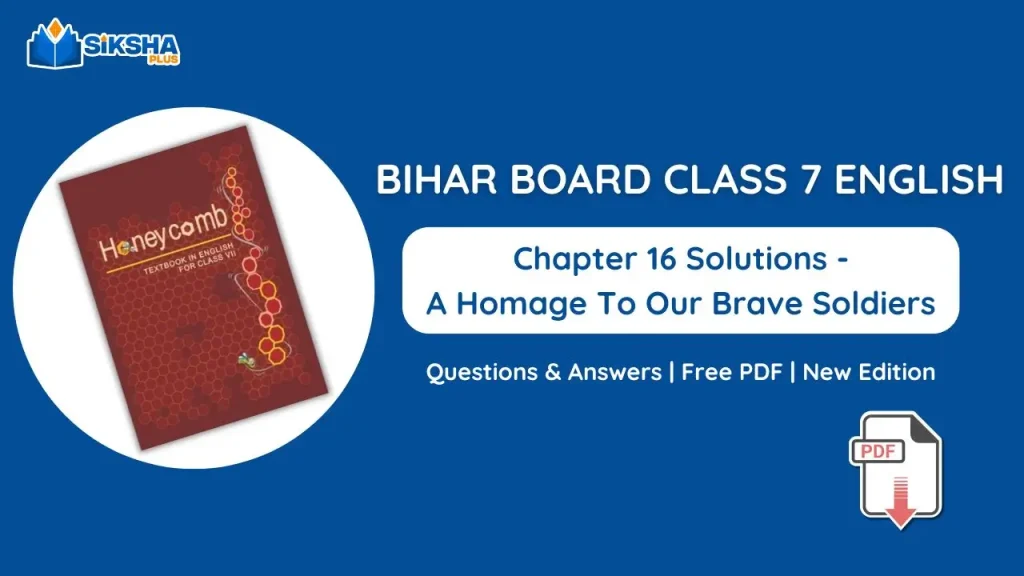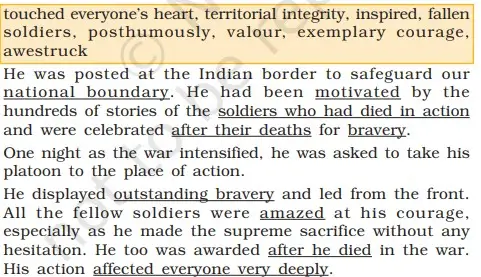Bihar Board Class 7 English Chapter 16 Solutions is available for free here. It covers all question answers of chapter 16 – “A Homage To Our Brave Soldiers”, from new book – Honeycomb.
“A Homage To Our Brave Soldiers” is a heartfelt chapter that honors the Indian Army soldiers who protect our country in harsh conditions like snowy mountains and hot deserts. The chapter describes the courage and sacrifices these brave men and women make for our safety and freedom. Students will learn about the difficult lives of soldiers who stay away from their families to guard our borders and keep us safe. On this page you will get written solutions of chapter 16 – “A Homage To Our Brave Soldiers” for free.

Bihar Board Class 7 English Chapter 16 Solutions
Contents
| Class | 7 |
| Subject | English (Honeycomb) |
| Chapter | 16. A Homage To Our Brave Soldiers |
| Board | Bihar Board |
COMPREHENSION CHECK
From Page number 126.
1. Where is the National War Memorial located and what is its significance?
Ans: The National War Memorial is located in New Delhi, India. It honors brave soldiers who died for our country. The memorial helps us remember their sacrifices and gives people a special place to pay respect to these heroes who protected our nation.
2. What is the nation’s highest gallantry award?
Ans: The nation’s highest gallantry award is the Param Vir Chakra. It is given to soldiers who show extreme bravery or perform outstanding acts of courage while facing the enemy.
3. What do the walls of Chakras portray?
Ans: The walls of Chakras at the National War Memorial show different parts of a soldier’s journey. Amar Chakra represents immortality, Veerta Chakra shows the bravery of soldiers through pictures, Tyag Chakra lists the names of soldiers who died, and Raksha Chakra shows the spirit of protection with rows of trees.
4. Find in the lesson the paragraph/s and the sentence that evoke the feelings given below.
(i) Feeling of wonder.
Ans: “The National War Memorial stands as a grand tribute, with its towering 15-meter-tall obelisk and eternal flame, symbolizing the undying spirit of the fallen heroes.”
(ii) Heartening.
Ans: “The names of thousands of brave soldiers inscribed on the walls of the memorial reminded us of their supreme sacrifice. It was heartening to see visitors bowing their heads in respect, uniting in gratitude for our heroes.”
(iii) Sense of motivation.
Ans: “The teacher shared with us the citation of Param Vir Chakra awardee Lance Naik Albert Ekka. His bravery and sacrifice deeply moved me and filled me with a sense of purpose. I was inspired to be courageous like him and serve my nation with unwavering dedication.”
(iv) Pride.
Ans: “As I walked through the memorial, reading about the courageous acts of our soldiers, my heart swelled with pride. Their selfless service has ensured the safety and honor of our great nation.”
(v) Visually inspiring.
Ans: “We spent the whole day, from morning to evening, at the National War Memorial and the surrounding areas, marked by majestic lawns and grand buildings of Kartavya Path. We were immersed in the ambience that was solemn and a reminder of what a free nation could achieve.”
(vi) Sadness.
Ans: “It was deeply saddening to see the endless names of fallen soldiers who had sacrificed their lives. Each name represented a story of loss, bravery, and an unfulfilled future.”
(vii) Gratitude.
Ans: “I felt immense gratitude for the soldiers who had given their lives for our country. Their sacrifices ensure that we live in peace and freedom today.”
(viii) Inspiration.
Ans: “The stories of bravery and sacrifice enshrined in the memorial remind me that true greatness lies in serving others. I walked away feeling inspired to contribute meaningfully to my country and uphold the values these heroes fought for.”
COMPREHENSION CHECK
From Page number 133.
1. Which book does Ananda want to read and why?
Ans: Ananda wants to read a memoir titled “Tiger of Drass-Capt. Anuj Nayyar-23-Kargil Hero” written by his mother Meena Nayyar. She wants to read it because it tells stories about brave soldiers who received the Param Vir Chakra award, which inspires her.
2. How did Ananda feel after reading about the National War Memorial?
Ans: After reading about the National War Memorial, Ananda felt deep respect and admiration for the soldiers. She was touched by their bravery and the sacrifices they made for the country.
3. Why was she reminded of the poem Pushp ki Abhilasha?
Ans: Ananda was reminded of the poem “Pushp ki Abhilasha” because it talks about wanting to be useful to the nation, just like soldiers are useful through their sacrifices for the country.
4. Reading the letter from Soumya, Anada is inspired to act. What actions does she intend to take up. Fill in the table citing the sentences from the text.

Ans:
| ACTION | SENTENCE |
|---|---|
| (i) Visit | We all wish to visit the National War Memorial. |
| (ii) Mobile app | I plan to create a mobile app to help people learn more about the sacrifices of our soldiers. |
| (iii) Sharing ideas | I am going to share the idea with my classmates. |
| (iv) Creating a collage | I want to create a collage to depict the bravery and stories of our soldiers. |
| (v) Joining the army | I aspire to join the army as it can be a life-changing experience filled with challenges and honor. |
| (vi) Website | I’m thinking of developing a website dedicated to our brave soldiers and their stories. |
WORKING WITH THE TEXT
1. Why are war memorials built?
Ans: War memorials are built to honor the soldiers and civilians who died in wars. They help us remember their bravery and sacrifice. These memorials teach us about our history and make us feel thankful for those who protected our country. They also remind us how important peace is and help us understand the cost of war.
2. Why is it our duty to pay homage to our brave soldiers?
Ans: It is our duty to pay homage to our brave soldiers because they risk their lives to keep us safe. They leave their families behind to protect our country. By honoring them, we show that we are thankful for their service. It also helps us remember their bravery and teaches younger people to respect and value what soldiers do for the country.
3. Why is it a good idea to make a presentation in front of the whole school?
Ans: Making a presentation in front of the whole school is a good idea because it helps many students learn about our brave soldiers at once. It creates awareness about the sacrifices made by soldiers and encourages students to feel proud of our country. Presentations can include pictures and stories that make students understand better. It can also inspire students to think about how they can help their country too.
4. Why were the students awestruck and humbled – explain in your own words?
Ans: The students were awestruck and humbled because they learned about the amazing courage shown by soldiers. They realized that these soldiers gave up their lives so that everyone else could live safely. Understanding these sacrifices made the students feel small compared to the greatness of these heroes. They felt grateful for the peace they enjoy because of these brave soldiers.
5. Complete the table given below. You may have to find the information from the Internet.
Ans:
| Names of Wars | Dates | Soldiers Associated |
|---|---|---|
| Indo-China War | 1962 | Indian Army and PLA (People’s Liberation Army) of China |
| India-Pakistan Wars | 1947-48, 1965, 1971, 1999 | Indian Army and Pakistan Army |
| Kargil War | May-July 1999 | Indian Army and infiltrators from Pakistan Army |
WORKING WITH LANGUAGE
1. Find the odd one out from the words given in the box.

Ans:
- Martyr
- Victory
- Respect
- Simple
2. Fill in the blanks with appropriate form of the word given in brackets.
The Param Vir Chakra signifies the “Wheel of the Ultimate Brave”, and the award is granted for “most conspicuous bravery in the presence of the enemy”. The medal was __________ (institute) as a Gallantry Medal with retrospective effect from 15 August 1947 by Dr. Rajendra Prasad, the then President of India. The Medal was __________ (design) by Mrs. Savitri Khanolkar. The designer __________ (draw) inspiration from Sage Dadhichi, a vedic rishi who __________ (make) the ultimate sacrifice by giving up his body so that the gods __________ (can) make a deadly weapon __________ (call) Vajra or Thunderbolt from his spine.
The medal is cast in bronze. In the centre, on a raised circle, is the state emblem, __________ (surround) by four replicas of Indra’s Vajra are __________ (flank). The decoration is suspended from a straight swiveling suspension bar, and is held by a 32 mm purple ribbon
Ans:
The Param Vir Chakra signifies the “Wheel of the Ultimate Brave”, and the award is granted for “most conspicuous bravery in the presence of the enemy”. The medal was instituted (institute) as a Gallantry Medal with retrospective effect from 15 August 1947 by Dr. Rajendra Prasad, the then President of India. The Medal was designed (design) by Mrs. Savitri Khanolkar. The designer drew (draw) inspiration from Sage Dadhichi, a vedic rishi who made (make) the ultimate sacrifice by giving up his body so that the gods could (can) make a deadly weapon called (call) Vajra or Thunderbolt from his spine.
The medal is cast in bronze. In the centre, on a raised circle, is the state emblem, surrounded (surround) by four replicas of Indra’s Vajra are flanked (flank). The decoration is suspended from a straight swiveling suspension bar, and is held by a 32 mm purple ribbon.
3. Match the following words with their meanings.
Ans:
| Word | Meaning |
|---|---|
| (i) Territorial integrity | (x) Safeguarding nation’s borders |
| (ii) Iconic | (i) Celebrated |
| (iii) Envisioned | (iv) Visualised |
| (iv) Etched | (ii) Engraved |
| (v) Posthumously | (vi) After death |
| (vi) Awestruck | (vii) Amazed |
| (vii) Obelisk | (v) A tapering stone pillar |
| (viii) Majestic | (iii) Grand |
| (ix) Interminable flame | (viii) Never dying flame |
| (x) Valiant | (ix) Very brave |
4. Complete the story of an unknown soldier. Replace the words from the box with the underlined words given in the text below.

Ans:
He was posted at the Indian border to safeguard our territorial integrity. He had been inspired by the hundreds of stories of the fallen soldiers and were celebrated posthumously for valor. One night as the war intensified, he was asked to take his platoon to the place of action. He displayed exemplary courage and led from the front. All the fellow soldiers were awestruck at his courage, especially as he made the supreme sacrifice without any hesitation. He too was awarded posthumously in the war. His action touched everyone’s heart.
